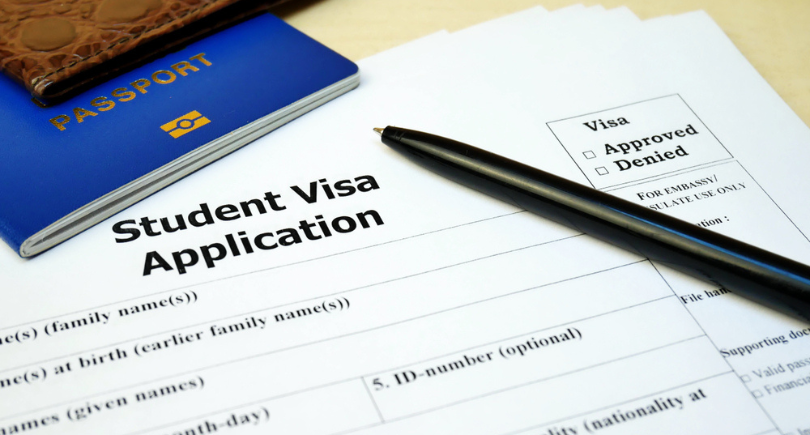
Moving to the United States can be a major adjustment – regardless of whether you are coming here as a foreign student, new citizen or worker with a visa. Among the many changes you’ll need to navigate is the process of setting up new financial accounts. And if you want a credit card from a U.S. issuer, you have additional hurdles to clear.
Keep reading for a comprehensive overview of everything you need to know about building credit and successfully applying for a credit card in the United States.
Why is it challenging for international students to get a credit card?
International students – or really anyone new to the country – have a difficult time receiving credit cards because they typically lack two things:
- Credit history
- Social Security number
A credit history and credit score indicate how responsible you are with your money. It’s how credit card issuers decide whether you can be trusted to pay back any money you owe.
However, only U.S. creditors typically report to the credit reporting companies used by American lenders. What’s more, lenders use a Social Security number to look up your credit history. Without a Social Security number to give lenders and without a credit history for them to review, it’s unlikely you’ll be approved for a credit card.
But don’t despair! We’ll walk you through how to resolve both problems below.
The importance of building credit
Let’s start by talking a little more about why credit is important and how you can build up a credit history in the U.S.
Every country’s financial and lending institutions have their own individual ways in which they judge the financial worthiness of a borrower. Some, like Canada and England, have scoring models that are similar to the United States so you may not have too much credit scoring culture shock if you’ve moved from those countries. Other countries, such as many in Africa, have a very weak system or no credit reporting system at all.
“Credit cards allow you to start building credit, especially if the long-term plan is to stay in the U.S. after graduation, and they are great to have in an emergency,” notes Linda Simpson, professor of financial literacy at Eastern Illinois University. “Establishing a good credit history is vital when making big financial decisions in the future such as purchasing a home or car. Responsible use of credit is key to building a solid reputation with lenders if you end up applying for citizenship or residency.”
That means, depending on your home country, the following information may sound very familiar, or it could be uncharted territory.
How credit bureaus work in the United States
America has three main credit reporting companies: TransUnion, Experian and Equifax. They collect financial data on you and share that information with lenders upon request.
The information collected by these companies includes the following:
- Open lines of credit
- Amount owed on each account
- Payment history
- Any negative account activity such as defaulting on repayment or declaring bankruptcy
Since credit reports can have such a significant impact on a person’s finances, the government has enacted certain safeguards such as guaranteeing residents the right to review their credit report for free once per year.
“Credit reports should be reviewed at least once per year but can be requested from each of the three credit reporting agencies; therefore, a free credit report can be requested three times per year,” explains Simpson. “For example, a report can be requested in March from Equifax, July from TransUnion, and November from Experian.”
What is a good credit score in the United States?
While lenders may review your entire credit report, many credit card issuers are mainly interested in your credit score. Simpson stresses, “The higher the credit score, the more likely you will receive lower interest rates on credit cards, mortgages, or automobile loans.”
A credit score is calculated using the information in your credit report. There are two companies that create the credit scores used by most lenders today – FICO and VantageScore. Each company has a different formula for its scores, but both use numbers ranging from 300-850, with the higher the number meaning the better the credit score.
Some U.S. credit cards are available to those with poor or fair credit, but you’ll need good to excellent credit to get the best credit cards. Every lender may have their own definition of good credit, but Experian says a score higher than 660 is usually considered good. Once you get into the 700-800s, your credit is considered very good to excellent.
What’s in a credit score?
Fortunately, we know exactly what goes into a credit score. FICO says it uses these categories weighted by the following percentages:
- Payment history (35%) – Having a long record of on-time payments helps boost a credit score while late payments can take a serious toll on your score.
- Amounts owed (30%) – Ideally, you don’t want to carry a balance that is more than 30% of your credit limit. If you can keep your balance below 10% of your limit, that’s even better. These percentages are what are known as your credit utilization ratio.
- Length of credit history (15%) – A long credit history is better so it’s best not to close old accounts unless you have to.
- Credit mix (10%) – It’s better to have a variety of accounts, such as loans and lines of credit, rather than only credit cards in your credit history.
- New credit (10%) – Once you take out new credit, your score might dip slightly but this is usually temporary.
VantageScore doesn’t provide percentages for how they weigh their scores, but does offer the following:
- Total credit usage, balance and available credit (extremely influential)
- Credit mix and experience (highly influential)
- Payment history (moderately influential)
- Age of credit history (less influential)
- New accounts (less influential)
The same basic principles apply: make timely payments and avoid maxing out your lines of credit to keep your score in good shape.
Can a non-U.S. citizen get a credit card?
Now that we’ve gone over that background, it’s time to go back to the original question: Can I get a credit card as an international student?
Yes, but maybe not immediately. Here are the steps to follow:
- Open an account at an American bank: If you’re already living here (versus preparing to move to the United States), you’ve probably already done this. In any case, this is your first step. Credit card companies like to see that the borrower has a bank account – and preferably one in the country they are residing in.
- Find a job: Again, if you’re in the United States reading this, you probably have one – unless you’re a college student from another country. In that case, you might want to consider getting a part-time job, especially if getting a credit card is at the top of your priority list.
- Get a Social Security number or taxpayer identification number: Why? Because credit card issuers either will want your Social Security number or a taxpayer identification number as part of the application process.
- Sign a lease: This proves that you live locally, notes Simpson.
- Put bills in your name: Simpson also recommends paying utility and/or cell phone bills that are in your name on time.
How to get a Social Security number
Only non-citizens who are authorized to work in the United States are eligible to receive a Social Security number, according to the Social Security Administration.
Immigrants can apply for one in their home country as part of the process of applying for an immigrant visa. If you didn’t get a Social Security number, or SSN, before you came to the United States, you’ll want to visit a local Social Security office in person. International students should check in with their school to determine of there are jobs available that would make them eligible for a SSN.
Depending on whether you are an immigrant or non-immigrant, you’ll need to bring Form I-551, Form I-94, Form I-766 and/or Form I-20 to your appointment. You’ll also need to bring your foreign birth certificate to prove your age. For more information, visit the Social Security Administration online.
Can you get a credit card without a Social Security number?
If you aren’t eligible for a Social Security number, you have another option. The IRS issues individual taxpayer identification numbers, also known as ITINs, to those who don’t have Social Security numbers.
According to the IRS, there are three ways to get an ITIN:
1. Mail your W-7, a federal tax return, proof of identity and original foreign status documents or certified copies from the issuing agency to:
Internal Revenue Service
Austin Service Center
ITIN Operation
P.O. Box 149342
Austin, TX 78714-9342
2. Apply in person using the help of an IRS-authorized Certifying Acceptance Agent, who can be found both in the U.S. and abroad.
3. Make an appointment at a designated IRS Taxpayer Assistance Center.
Using an in-person option may be preferable so you don’t have to send original documentation through the mail.
I have a bank account, job and SSN/ITIN. Now can I get a credit card?
Maybe – and maybe not.
You can certainly apply for one, and you may get approved. But whether you get one depends largely on your credit history, and you probably don’t have much of a credit history yet. It also depends on how much income your job pays. If you make a solid salary, some credit card issuers may overlook the fact that you don’t have any credit history.
At this point, your best bet may be to look for a card that accepts applicants with limit credit and apply. There is no charge to apply for a card so the worst that can happen is a denial.
However, be selective about your applications. Applying for many cards at once can be a red flag for creditors so limit yourself to one or two applications at first.
What is the best credit card for immigrants?
Assuming you are starting from scratch and have no credit history, you’ll need to begin with a credit card designed for someone with poor to fair credit. That may mean getting a secured card.
Secured credit cards operate like any credit card, but they require you to make a deposit when opening the account. So, for instance, you might give a secured credit card company $500, and they will issue you a card with a $500 credit limit. Then maybe you buy $100 worth of merchandise using your credit card and pay $100 back by the due date.
If you do that for several months – buy some stuff and pay for it before the due date – you’re showing the credit card issuer that you know how to use a credit card responsibly. This is what will build your credit history and score and eventually open the door to better, unsecured credit card options.
Some of our top picks for the best secured cards include:
- CardName: If you want rewards, the CardName provides 2% cash back on up to $1,000 spent each quarter on gas and restaurants and 1% cash back on all other purchases. There is no annual fee with this card either.
- CardName: There are no rewards earned on purchases, but this card comes with perks such as rental car insurance and roadside assistance. Plus, there is no annual fee for this card.
- CardName: You will pay an annual fee for this card, but it doesn’t require a credit check which can be beneficial to some people.
You want to use your secured credit card just as you would a conventional credit card. Eventually, usually between six and 12 months, you’ll be allowed to move up from the credit card company’s secured credit card to an unsecured, or traditional, credit card. And, yes, if you used the secured card responsibly and made all your payments, you’ll get your deposit back.
Be aware that not all secured credit cards report your payments to all three credit bureaus, which will make it more difficult to build your credit history. Most major banks issuing secured cards will report to the bureaus but ask specifically just to be sure.
Which credit card is best for international students?
Although there are no guarantees, international students may find they are eligible for student credit cards which are designed for those with limited incomes and credit history.
Our top overall picks for student credit cards include CardName and CardName. However, for international students, we recommend the CardName since it does not require a Social Security number from foreign students.
Regardless of whether you apply for a secured or unsecured card, look for the following details before applying:
- Annual fee: An annual fee is what you will pay each year simply for the privilege of having the card. For secured cards, this amount is addition to the security deposit you’re required to make to establish your line of credit.
- Interest rate: It’s best to pay off your balance each month. Doing so will save you money and boost your credit score. However, if you think you might carry a balance, look for a card with the lowest interest rate possible.
- Other fees: Every credit card application will include a disclosure of the card’s fees. In addition to the annual fee, look for charges such as late payment fees, over-the-limit fees and foreign transaction fees, which could be expensive if you use the card when you are in your home country. While you can’t avoid all fees, compare cards to find one with lower costs.
- Grace period: Most traditional credit cards offer a grace period before they begin charging interest on your purchases. This is generally 21 days between when your billing cycle closes and when your bill for that statement is due. If you can find a card with a longer grace period, all the better.
- Rewards earned: Some credit cards offer rewards, such as cash back or miles, which are earned on eligible purchases made with the card. This could be an incentive to choose one card over another, if the other perks of the card also meet your needs.
Other options for building credit
If you can’t get your own credit card, there are two other ways to potentially build credit.
- Find a co-signer: You could try applying for a card jointly with someone you trust, such as a relative in America. But if you have trouble paying off the card, your relative will be legally responsible for the debt. As a result, it can be hard to find people willing to co-sign on a card.
- Become an authorized user: Another option is to ask someone with an existing credit card to make you an authorized user. This allows you to use the card, and your credit report gets the benefit of their good credit score. Some people may balk at adding an authorized user because it’s the primary cardholder who remains responsible for paying off any debt. However, you can get a credit score boost simply by being an authorized user even if you never actually use the card.
With authorized users, keep in mind that this strategy could backfire if the primary cardholder isn’t financially responsible. If they start missing payments on a card that includes your name, it could drag down your credit score as well.
Handling credit once a card is issued
Professor Simpson recommends the following steps:
- Make a budget and stick to it. There is a tendency to spend more when using a credit card rather than cash.
- Use the credit card. This behavior provides evidence that you can handle and use credit responsibly.
- Make at least the monthly payment on time each month but a better strategy is to pay the balance in full to avoid interest charges.
- Set up automatic payments to prevent late or missed payments.
- Set up text or email alerts to notify you of your balance and due date.
- Carefully review each monthly statement to monitor spending, keep track of payment dates, and any unauthorized purchases.
In addition to the above, Simpson cautions against:
- Falling into a minimum payment habit: The minimum payment on a credit card is typically 3-4% of the balance and is barely enough to pay for interest in a given month.
- Retail Store Charge Cards: Avoid running a balance on retail store charge cards. These cards can be are appealing and are often presented at the point of checkout offering a discount on n extra 10% off your total purchase, if you complete the credit card application. While taking advantage of this savings is tempting, remember that retail cards typically charge high interest rates.
- Teaser rates: Introductory rates may be offered for a limited amount of time but once that time period is over, the interest rate on any unpaid balance can increase significantly. Be sure that the balance is brought down to $0 before the free financing or introductory offer expires.
In short, none of this may be easy, but then moving to another country never is. It’s at once exciting and an exercise in patience. However, with a little time and effort, you may find you soon you’ll have a U.S. credit card of your own.


